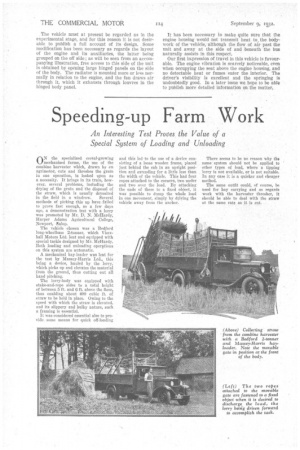Speeding-up Farm Work
Page 56

If you've noticed an error in this article please click here to report it so we can fix it.
An Interesting Test Proves the Value of a Special System of Loading and Unloading
ON the specialized cereal‘grovving mechanized farms, the use of the combine harvester which, drawn by tm agrimotor, cuts and threshes the grain in one operation, is looked upon as a necessity. It brings in its train, however, several problems,. including the dtying of the grain and the disposal of the straw, which is usually deposited in the field in a windrow. Several methods of picking this up have failed to prove fast enough, so a few days ago, a demonstration test with a lorry was promoted by Mr. D. N. McHardy, Harper Adams Agricultural College, Newport, Salop.
The vehicle chosen was a Bedford long-wheelbase 2-tonner, which Vauxhall Motors Ltd. lent and equipped with special tackle designed by Mr. McHardy. Both loading end unloading opereions on this system are automatic.
A Mechanical hay-loader was lent for the test by Massey-Harris Ltd., this being a device, haukil by the lorry, which picks up and elevates the material from the ground, thus cutting out all hand pitching.
The lorry-body was equipped with stake-and-rope sides to a total height of between 5 ft. and G ft. above the floor, thus enabling about 400 cubic ft. of straw to be held in place. Owing to the speed with which the straw is elevated, and its slippery and bulky nature, such a framing is essential.
It was considered essential also to provide some means for quick off-loading and this led to the use of a device consisting of a loose wooden frame, placed just behind the cab in an upright position and extending for a little less than the width of the vehicle. This had four ropes attached to the corners, two under and two over the load. By attaching the ends of these to a fixed object, it was possible to dump the whole load in one movement, simply by driving the vehicle away from the anchor.
There seems to be DO reason why the same system should not be applied to other types of load, where a tipping lorry is not available, or is not suitable. In any case it is a quicker and cheaper method.
The same outfit could, of course, be used for hay carrying and as regards work with the harvester thresher, it should be able to deal with the straw at the same rate as it is cut.












































































































